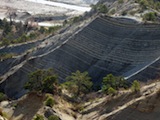Mathieu Martinez PhD thesis
 Astronomical calibration of the Valanginian and Hauterivian stages: palaeoclimatic and palaeoceanographic implications
Astronomical calibration of the Valanginian and Hauterivian stages: palaeoclimatic and palaeoceanographic implications
Defended on the 3rd June 2013
Funding: Ministry of higher education and research + ANR Astronomical time scale for the Cenozoïc and Mesozoïc era (leaded by J. Laskar, Observatoire de Paris)
Supervisor: Jean-François Deconinck; cosupervisor: Pierre Pellenard
Started in October 2009
Summary
The Geological Time Scale shows numerous uncertainties on the Valanginian-Hauterivian interval (Early Cretaceous) that impacts on the palaeoceanographic reconstructions. Notably, the chronological reliationships between the positive excursion in ?13C in the middle Valanginian (the “Weissert Event”), the Faraoni oceanic anoxic event (latest Hauterivian) and the Paraná-Etendeka traps are badly understood. This works presents the results of an orbital calibration of the Valanginian Stage and part of the Hauterivian Stage, based on the record of the eccentricity cycle on palaeoclimate proxies measured at a high resolution, in the alternating series of the Vocontian Basin (SE France) and the Subbetic Domain (SE Spain).
A total of 3,000 gamma-ray spectrometry measurements, performed every 20 cm on five Valanginian reference sections in the Vocontian Basin, allowed the identification of the various orbital parameters. A duration of 5.08 myr is proposed for the Valanginian Stage, based on the identification of the 405-kyr eccentricity cycle. This duration combined with available radiometric ages, shows that the Weissert Event is prior to the onset of the Paraná-Etendeka activity. In addition, a stronger expression of the obliquity cycle in the Upper Valanginian (Nicklesi and Furcillata subzones) may reflect the development of low-extension polar ice.
A multi-proxy approach on the Hauterivian-Barremian transition in the Río Argos section (Subbetic Domain) shows cyclic fluctuations in detrital supplies and continental weathering conditions linked to the marl-limestone alternations. Marl interbeds were deposited in a humid climate marked by a strong continental weathering, while limestone beds were deposited under semi-arid conditions. An orbital calibration based on magnetic susceptibility, CaCO3 contents and clay minerals allowed the Ohmi and Hugii zones to be assessed at 0.78 and 0.54 myr, respectively. The Faraoni event has a duration comprised between 100 and 150 kyr. By correlation with other sections in the Western Tethys, Río Argos appears to be the best GSSP candidate for the Hauterivian-Barremian boundary.
Keywords
Valanginian, Hauterivian, Milankovitch cycles, cyclostratigraphy, gamma-ray spectrometry, magnetic susceptibility, palaeoclimatology, palaeoceanography
PhD committee
François Baudin (Pr., université Paris VI)
Fabrice Monna (Pr., université de Bourgogne)
- extrait:
- lien_externe:
- kc_data:
- a:8:{i:0;s:0:"";s:4:"mode";s:0:"";s:3:"css";s:0:"";s:9:"max_width";s:0:"";s:7:"classes";s:0:"";s:9:"thumbnail";s:0:"";s:9:"collapsed";s:0:"";s:9:"optimized";s:0:"";}
- kc_raw_content:
 Astronomical calibration of the Valanginian and Hauterivian stages: palaeoclimatic and palaeoceanographic implications
Astronomical calibration of the Valanginian and Hauterivian stages: palaeoclimatic and palaeoceanographic implicationsDefended on the 3rd June 2013
Funding: Ministry of higher education and research + ANR Astronomical time scale for the Cenozoïc and Mesozoïc era (leaded by J. Laskar, Observatoire de Paris)
Supervisor: Jean-François Deconinck; cosupervisor: Pierre Pellenard
Started in October 2009
Summary
The Geological Time Scale shows numerous uncertainties on the Valanginian-Hauterivian interval (Early Cretaceous) that impacts on the palaeoceanographic reconstructions. Notably, the chronological reliationships between the positive excursion in ?13C in the middle Valanginian (the "Weissert Event"), the Faraoni oceanic anoxic event (latest Hauterivian) and the Paraná-Etendeka traps are badly understood. This works presents the results of an orbital calibration of the Valanginian Stage and part of the Hauterivian Stage, based on the record of the eccentricity cycle on palaeoclimate proxies measured at a high resolution, in the alternating series of the Vocontian Basin (SE France) and the Subbetic Domain (SE Spain).
A total of 3,000 gamma-ray spectrometry measurements, performed every 20 cm on five Valanginian reference sections in the Vocontian Basin, allowed the identification of the various orbital parameters. A duration of 5.08 myr is proposed for the Valanginian Stage, based on the identification of the 405-kyr eccentricity cycle. This duration combined with available radiometric ages, shows that the Weissert Event is prior to the onset of the Paraná-Etendeka activity. In addition, a stronger expression of the obliquity cycle in the Upper Valanginian (Nicklesi and Furcillata subzones) may reflect the development of low-extension polar ice.
A multi-proxy approach on the Hauterivian-Barremian transition in the Río Argos section (Subbetic Domain) shows cyclic fluctuations in detrital supplies and continental weathering conditions linked to the marl-limestone alternations. Marl interbeds were deposited in a humid climate marked by a strong continental weathering, while limestone beds were deposited under semi-arid conditions. An orbital calibration based on magnetic susceptibility, CaCO3 contents and clay minerals allowed the Ohmi and Hugii zones to be assessed at 0.78 and 0.54 myr, respectively. The Faraoni event has a duration comprised between 100 and 150 kyr. By correlation with other sections in the Western Tethys, Río Argos appears to be the best GSSP candidate for the Hauterivian-Barremian boundary.
Keywords
Valanginian, Hauterivian, Milankovitch cycles, cyclostratigraphy, gamma-ray spectrometry, magnetic susceptibility, palaeoclimatology, palaeoceanography
PhD committee
François Baudin (Pr., université Paris VI)
Fabrice Monna (Pr., université de Bourgogne)
